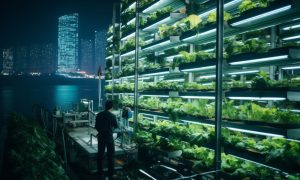As a latest trend and innovation, the filtration used in HVAC systems comes in the grade of MERV 4 up to MERV 16 and HEPA Filter.
As per study conducted, people spend close to 80 percent of the time indoors at home, office and other type of buildings and now given the Covid-19 pandemic issues the time spend indoors is close to 95 percent as per source. The filters are now a very crucial part of the Heating ventilation and air condition (HVAC) systems primarily essential for a healthy indoor climate and to protect people’s health with clean and fresh (IAQ) indoor air quality.
Air filters and cleaners in HVAC systems
The air filter is designed and implemented as a standard filtration component as part of any Heating ventilation and Air-conditioning (HVAC) System from a smaller capacity of a Split type Air conditioners used at Home / Work space onto larger capacity of Air Handling units (AHU) connected to a centralized Air conditioning system like Chillers, which is used in a larger applications like hotels malls, multi-tenant building, commercial building, industries etc. These filters are focused primary to filter dust, bacteria, virus, pollen and other small particles out of the air which we breathe and also helps protect the external and internal components like the fans, coil, compressors on the HVAC systems.
Growth in coming times
The Future of Air Filters market is projected to grow from USD 13.75 Billion in 2021 to USD 22.15 Billion in 2028 at a CAGR of 7.1 percent from the 2021 ~ 2028 period as per source.
The air cleaner is a mobile air purification device that circulates the room air using circulating air removes contaminants from the air in a room to improve quality. They are either small stand-alone units or larger units that can be placed on the floor within a room space with a single to two filtration processes. The Air cleaner are equipped with either F7 filter, HEPA Filter to a AirFendTM technology to address the air containments microbial particles such as bacteria, yeasts, viruses and the recent covid-19 virus.
The global air cleaner market is expected to expand at a compound annual growth rate (CAGR) of 10.0 percent from 2021 to 2028 s per source.
According to a study conducted by the university of Helsinki, Finland, it was proven that either a filtration unit or an air purifier should consistently draw enough air to reduce the number of particles that carry the virus and persist in the air.
Therefore, such Air cleaner and Air filters can help reduce airborne contaminants in a building or any closed environment applications.
Technology to meet requirements for air quality
Yes, it is the need of the hour to innovate and deploy such efficient filter which directly effects on the quality of air we breathe and affecting human health and productivity.
As per reports, every day we consume 1 Kg. of food drink; 2 litres of water, but we inhale 20,000 litres of air, hence good quality air is very important for a good health, comfort, productivity and over wellbeing of people. With poor quality of air, we see people undergoing a syndrome called “Sick Building Syndrome “which is a condition in which people in a building suffer from symptoms of illness or become infected with chronic disease from the building in which they work or reside. As per World Health Organization (WHO) report suggests up to 30 percent of new and remodelled buildings worldwide may be subject of complaints related to poor indoor air quality leading Sick building syndrome (SBS).
To add to this, we have the coved -19 which is a virus sized at ≈0.1 am in diameter and transmits when people breathe in air contaminated by droplets and small airborne particles.
New and innovative air filters technologies
Hence as a latest trend and innovation, the filtration used in a HVAC system comes in the grade of MERV 4 up to MERV 16 and HEPA Filter, MERV stands “minimum efficiency reporting value” and a filter receives a MERV rating as determined by the American Society of Heating, Refrigeration, and Air- Conditioning Engineers (ASHRAE). On average, many facilities are limited to a MERV 8 or MERV 9 filter type A HEPA filter is essentially the ultimate solution in the air filter All HEPA filters have a rating of a MERV 17 or higher. A HEPA filter with a MERV 17 rating will trap 99.97 percent of air particles that are 0.3-1.0 micron in size and an even better percent of particles below 0.3 microns and above, hence the HEPA filters in most of the air filtration units are certified to capture almost 96 percent of the Covid causing germs.
In Air handling units MERV 5 and MERV 8 filters could be installed before HEPA filters as a 2 steps process of filtration to reduce the dust loading and also help increase the life of the HEPA Filters.
Two steps filtration is recommended-
- Min. MERV 9 (M5) or if possible MERV 13 (F7) in the 1st stage
- Min. MERV 13 (F7) or if possible MERV 15 (F9) in the 2nd stage
- Min. MERV 13 (F7) if only one filter step is used.
The indoor contaminants are also gaseous contaminants such as VOC, NOxSox, Ammonia, Formaldehyde etc. Hence, Filter Media with activated carbon and activated alumna will also help remove these contaminants.
It is also noticed that an ePTFE media is superior than a glassier for HEPA filters, as efficiencies of ePTFE is 0.07 microns as against 0.13 microns of glass fibre it also offers 50 percent lower pressure drop and 8 times higher strength and higher dust holding capacity which improves the overall efficiency of the HVAC system.
Apart from the above innovation methods “Filters common best practise “should be followed during the working cycle of the HVACs system.
Few key best practises:
- Testing of Filter as per standard
- Monitor and Measure the Energy Consumption attributed from filters
- Measurement of IAQ
- Regular cleaning, washing or even revamp of the filter yearly /quarterly/monthly based on the application and dust engrossment.
A well maintained and operated air filtration unit inside an AC is linked with reducing the overall spread of Covid-19, especially in closed environments. The basis of selecting the right filters should be referred to ASHRAE 52.2 and to maintain the right Indoor Air Quality reference to be made to REHVA Covid-19 guidance document, April 3, 2020, ISHRAE Covid-19 April 13, 2020 and ASHRAE 62 norms.
IoT sensor market
The loT integrates all the devices onto a common platform showcasing the temperature or even the downtime of the equipment which helps the users take the preventive measures with technology advancement and integration of Lot sensor user are able to oversee the technical issue before it occurs. The Lot sensors are customized designed and integrated as per the site, application and business needs connected via the Bluetooth or Wi-Fi rooter devices to feed the crucial information.
Air curtain market
Air curtain-protected doorways were proven to save total building energy usage by a factor of 0.3-2.2 percent according to Wang’s studies. This illustrates they are equal or more effective at separating outdoor and indoor environments regardless of door opening styles or cycles.
Air curtains blow a controlled stream of air across an opening to the other side to create an air seal. This seal separates different environments while allowing a smooth, uninterrupted flow of traffic and unobstructed vision through the opening which helps maintain the required Temperature in such storage and warehouse.
The global Air curtain market is valued at USD 428.9 million in 2019. The market size will reach USD 528.7 million by the end of 2026, growing at a CAGR of 3.0 percent during 2021-2026.
Contributed by:
Mr. Sandeep Vasant
Sales Head and Business Development – INDIA ( PAC )
Fläkt Group
Cookie Consent
We use cookies to personalize your experience. By continuing to visit this website you agree to our Terms & Conditions, Privacy Policy and Cookie Policy.















